|
Generally, reptiles are cold-blooded vertebrates that breath air through their lungs and have scales, including snakes, lizards, turtles, and alligators. Snakes and lizards are the only reptilian residents of Capitol Reef. As ectotherms (cold-blooded animals), reptiles rely on warmth from the environment and therefore become inactive during cold winter months. During this period of seasonal inactivity (brumation) snakes and lizards shelter in rock crevices or underground burrows and their metabolic rate decreases, conserving energy. SnakesCapitol Reef is home to 6 snake species. Snakes are mostly solitary animals and may be seen basking on a sunlit rock or unseen taking shelter in a dark rock crevice. Snakes are predators that swallow their food whole. They have extremely flexible jaws that allow them to swallow animals bigger than their heads, like chipmunks and squirrels. 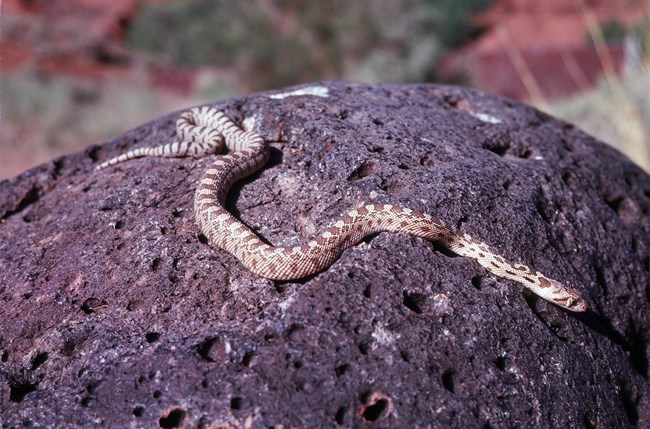
NPS Gopher SnakeGopher snakes (Pituophis catenifer) are found throughout most of North America and are common throughout Utah, including in the park. When alarmed, gopher snakes hiss and vibrate their tails, so they are often mistaken for rattlesnakes. Their diet consists of birds, bird eggs, small mammals, lizards, and insects. They are typically large, with individuals longer than 100 in (250 cm) in length not uncommon. Their backs are yellowish or cream colored with dark blotches, and their bellies are whitish or yellowish in color. Another common name for the gopher snake is bullsnake, which is technically a subspecies. 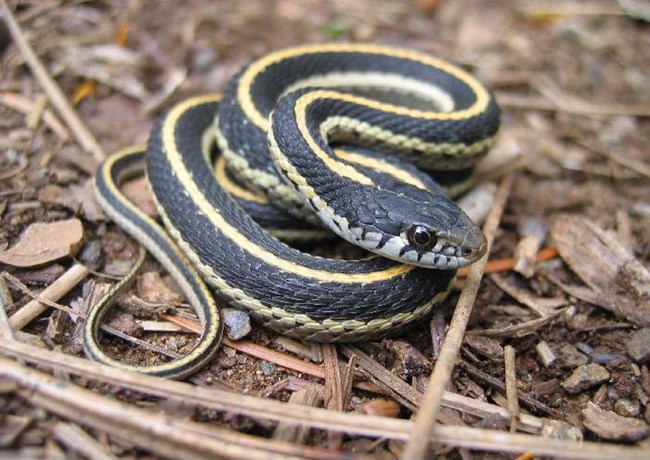
USFWS / James Bettaso Terrestrial Garter SnakeTerrestrial garter snakes (Thamnophis elegans) are common throughout the western US, especially in Utah including in the park. They typically have centered yellowish stripe running the full length of the body, up to 43 inches (109 cm). Their diet consists of worms, snails, amphibians, fishes, small rodents, and occasionally insects, lizards, small snakes, and small birds. They inhabit a variety of different environments. 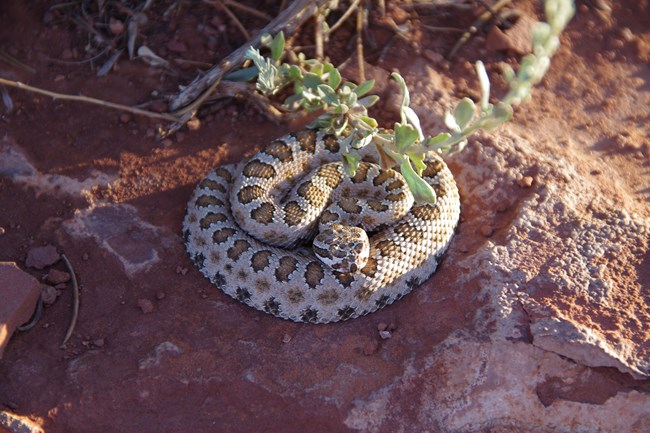
NPS / Antoine Boulore Midget Faded RattlesnakeMidget faded rattlesnakes (Crotalus oreganus concolor) are found in western Colorado, eastern Utah, and southern Wyoming. They are the only venomous snake in Capitol Reef and are common in the park. These snakes are typically tan, cream, or yellowish, with faint oval blotches on the back. They usually grow less than 24 in (61 cm) in length. They are primarily found on the ground, but will occasionally climb into trees and shrubs. Their diet consists of small mammals, birds, lizards, and occasionally amphibians. They subdue their prey by injecting venom through large hollow fangs at the front of the upper jaw. 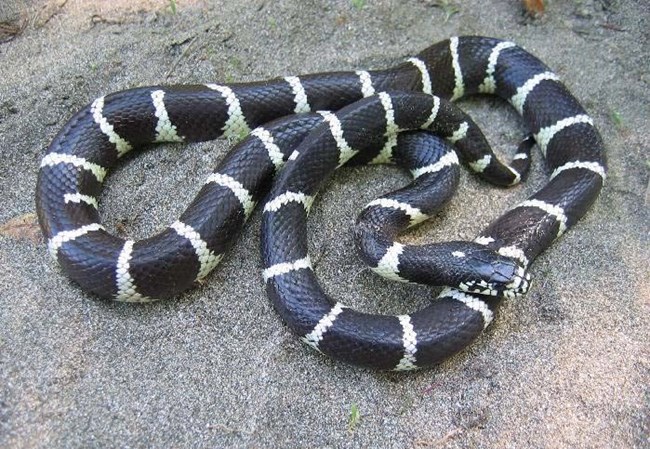
USFWS / James Bettaso Common KingsnakeCommon kingsnakes (Lampropeltis getula) are found throughout the US including in southern Utah but are rare in the park. These black and white patterned snakes can reach lengths of up to 85 inches (216 cm). They are found in desert scrub areas, agricultural areas, woodlands, and deserts. Their diet consists of reptiles, small mammals, and birds, as well as the eggs of both birds and reptiles. They are one of the few Utah animals that prey upon rattlesnakes. 
NPS Striped WhipsnakeStriped whipsnakes (Masticophis taeniatus) are found throughout the western US and are common in Utah, including in the park. They frequently have light-colored stripes on either side of a thick olive stipe down the middle of the back. They are slender snakes reaching lengths of up to 72 inches (183 cm). They inhabit grasslands, sagebrush flats, canyons, and pinyon-juniper forests, and are attracted to rocky streams. Their diet consists of lizards, small mammals, frogs, insects, and other snakes, even rattlesnakes. Whipsnakes are diurnal (active during the day) and are very fast.
Visit our keyboard shortcuts docs for details
A striped whipsnake slithers across bare ground. NPS / Lori Rome LizardsCapitol Reef is home to 10 species of lizards which are frequently seen in the park on warm sunny days. Many lizard species engage in amusing territorial behaviors; they do push-ups! Males can be spotted doing short rapid push-ups to defend their territories and attract females. In some lizard species, breeding males have brightly colored throats and abdomens to attract mates. Most lizards also have the unique defensive adaptation of being able to drop and regrow their tails. Losing a tail is energetically costly, but may allow a lizard to escape the jaws of a predator or distract one that is too close for comfort. 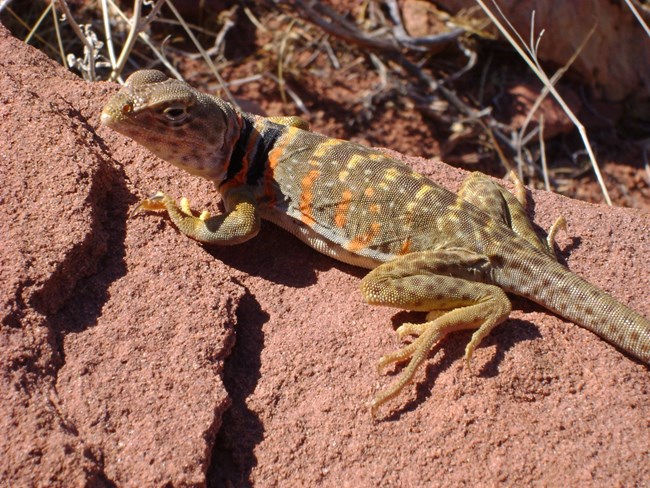
NPS / Hannah Newton Great Basin Collared LizardGreat Basin collared lizards (Crotaphytus bicinctores) are found throughout the western US including western Utah and are common in the park. Like many other lizards, they are attracted to rocky hilly terrain with generally scant vegetation. These areas provide rock crevices for shelter, warm basking sites, and lookouts for prey. Their diet consists of lizards, insects, spiders, and some plant material. 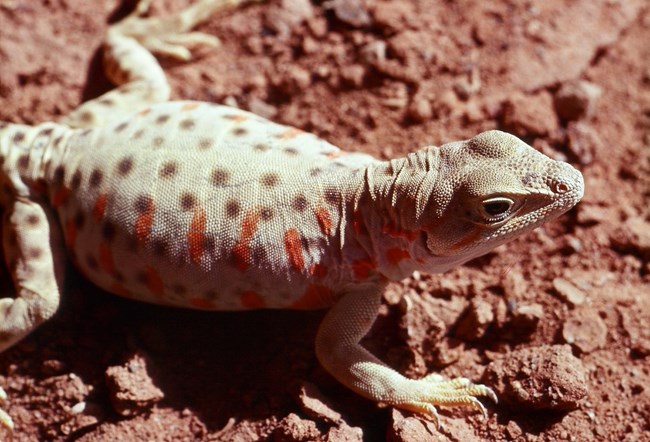
NPS Long-nosed Leopard LizardLeopard lizards (Gambelia wislizenii) are found throughout Utah in open desert and semi-desert areas and are common in the park. These lizards are mainly ground dwelling, but will occasionally climb into bushes. Their diet consists of insects, spiders, small rodents, lizards, and some plant material. These relatively large lizards can slightly alter their coloration for camouflage purposes. At top speeds they can run soley using their hind legs. 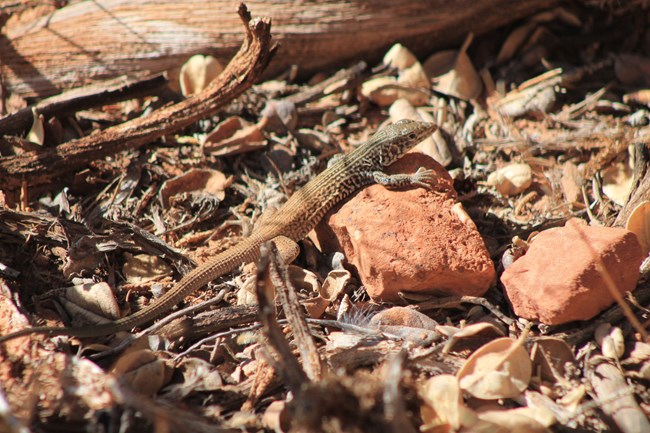
NPS Western WhiptailWestern whiptails (Aspidoscelis tigris) are the more common of the two species of whiptails found in Capitol Reef and are present throughout much of the western US. They are slender, long-tailed lizards with little differentiation between head and body. They primarily inhabit sparsely vegetated desert and shrubland habitats. During cold winter months, they often occupy underground burrows created by rodents or other lizards. Whiptails feed primarily on insects, scorpions, lizards, and spiders. 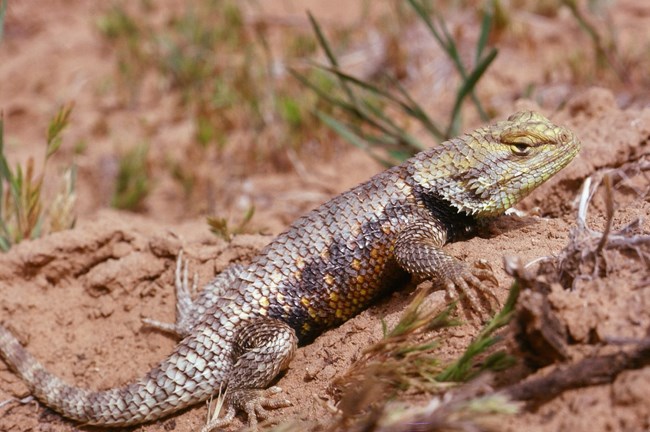
NPS Desert Spiny LizardDesert spiny lizards (Sceloporus magister) are stocky, have pronounced scales, and are of the spiny lizard family. They are native to southern and eastern Utah and common in the park. Their heads are yellowish orange while their bodies are flecked with gold or yellow. Desert spiny lizards have distinctive black marks on each side of their necks. They prefer arid habitats and are often found on rocks or in trees. Their diet consists of a variety of insects, lizards, and plant material. 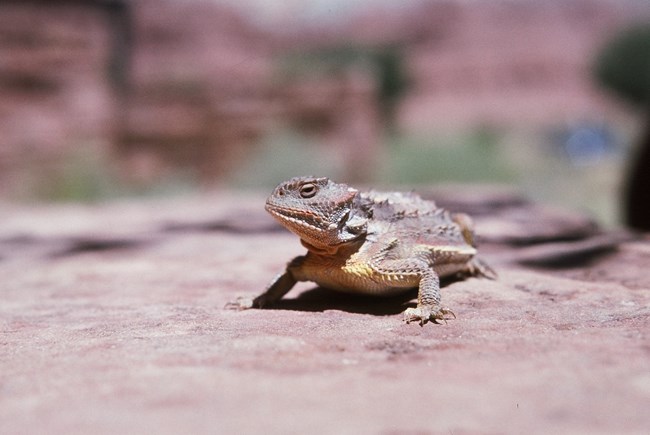
NPS Greater Short-horned LizardGreater short-horned lizards (Phrynosoma hernandesi) are of the spiny lizard family. They are found throughout much of the western US, including Utah, however they are rare in the park. They frequent a variety of habitats ranging from grasslands to high mountains. They feed primarily on ants, but also consume grasshoppers, beetles, and other invertebrates. Close relatives of this lizard have unique defensive adaptations to ward off predators such as snakes, hawks, and coyotes. They can inflate their bodies to about twice the normal size and can shoot streams of blood out of their eyes, which is noxious to canines and may confuse predators. 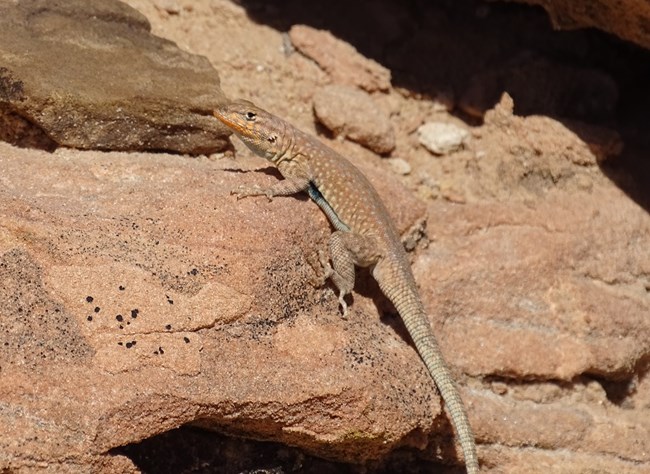
NPS Side-blotched LizardSide-blotched lizards (Uta stansburiana) are of the spiny lizard family. They are found throughout much of the western US, including Utah where they are abundant in the park. They are small grayish-brown lizards with dark blue to black patches behind their front legs. They inhabit areas of sandy or rocky soil containing scattered brush or trees and are primarily ground dwellers. Side-blotched lizards feed mainly on small invertebrates such as insects and scorpions, but adult males may cannibalize young lizards. 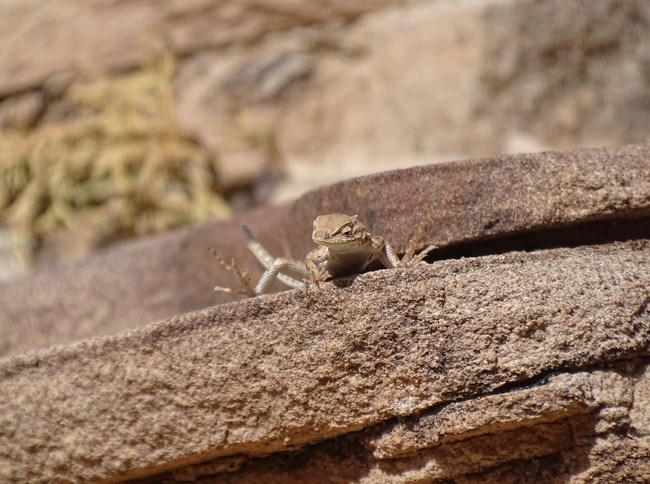
NPS / Emily Van Ness Other Spiny LizardsThe park is home to 6 species of Spiny Lizards, in the family Phrynosomatidae. Some of these lizards can be difficult to identify because they can range in appearance, have irregular patterning, and are often gray or brown. Breeding males are often easier to identify if able to view their brightly colored throats and necks. |
Last updated: May 7, 2024
